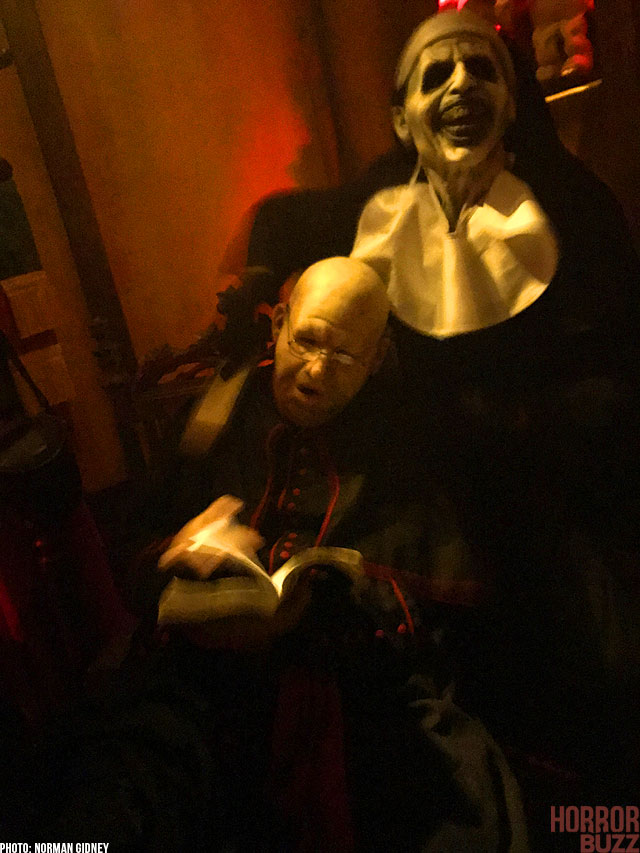With the recent debate over using real-life issues as thematic elements in haunts, haunt fans and owners are taking a closer look at where to draw the line when bringing dark, traumatic human experience into these fictional worlds. For one haunt in particular, the answer to that question is quite clear: there is no line, or if there is it’s like the foul line in the long jump, a point to look back on to see just how greatly it’s been exceeded.
Welcome to Gluttire University, the center of the world of The 17th Door. Receiving great praise for it’s beautiful makeup and breathtaking set design as well as considerable controversy for its uncomfortable themes and gross out tactics in its inaugural year; the experience has returned with a vengeance, pushing everything you loved and hated about the first year to even greater extremes. This year’s experience in a direct continuation of the plot of that first year, bringing us the sophomore year of our tragic protagonist, Paula. Paula, to say the least, is a troubled young woman. In her freshman year we got to see her quick and dramatic downward spiral as she battled bullying, bulimia, and an addiction to crystal meth. The good news is she seems to have kicked her meth habit, as there were no references to it and those familiar little baggies of blue crystals seen in the previous year’s venture are conspicuously absent. The bad news is, well, everything else really. If you were to throw a handful of darts at a bunch of mental and emotional issues, you can be sure that Paula has all of them.
In addition to the continued fallout of Paula’s poor life choices, this year we’re also given a window into her upbringing, and boy is it a doozy. Spoilers: there’s a bunch of pedophilia, and the topic is breached with all the subtlety of an edgy, runaway freight train. Immediately upon entering the fairly unassuming building in the middle of the Irvine Marketplace, (a seemingly bizarre choice for a haunt of this variety) guests are met with a large sign listing a laundry list of “trigger warnings”. It’s clear from the very beginning this is not an experience that pulls any punches, but it quickly becomes difficult to comprehend what they might be punching at.
At the end of the previous year’s misadventures, Paula found herself in an asylum, and this is where this year’s journey begins. After passing by the cages of the inmates, which I have to imagine breaks a number of code violations, guests receive an explanation of the basic rules of the haunt and the mercy system. As with many intense haunts, The 17th Door has a safe word; if the experience becomes too intense, haunt patrons need only yell “Mercy!” to move on to the next room, or in extreme cases, exit the haunt entirely. One important change to this system in this year’s run is that the performers no longer seem as compelled to use forced mercies to get visitors to do some of the more unpleasant tasks requested (such as kissing actual pig heads and raw fish). At least for our group, when someone didn’t want to do something, the issue was dropped rather than trying to force out the safe word to avoid a particular action.
I won’t spoil the majority of what occurs in most of the now 21 rooms, but after you make your way past the asylum you find yourself in a soundproofed child’s bedroom with a bunch of men viewing a camera feed and a lecherous priest standing there wielding a paddle. I don’t think I need to address the implications here, but as disturbing as they might be, this is one of the few instances where The 17th Door shows any degree of subtlety or restraint. As stated previously, the technical merits of what they’ve achieved here cannot be spoken of highly enough. The budget for this operation must have been staggering and everything from a visual perspective just works. Those areas that seem to represent Paula’s reality are crafted with utterly impeccable care, every small detail is accounted for and these spaces feel truly lived in. Likewise for more conceptual spaces used to represent her inner demons, these rooms are designed with a bleak surrealism that gives the impression that one has entered into this person’s own personal hell. Even the spaces between rooms, which were previously fairly sparse, are given the same care and attention, creating a seamless transition from one environment to the next.
One room I feel requires some attention is a sort of mini-escape experience. This occurs as part of the natural flow of the maze, and you move forward regardless of your success. This experience proves to be quite challenging, providing a scant 2.5 minutes to solve 4 puzzles. My team was unable to make it happen, and we got chastised for it by a couple of the actors, but otherwise we continued unimpeded. The experience seemed designed to be failed, but maybe that’s just me being salty and other groups will have no issue with it. The design of the puzzles themselves will be familiar to anyone that has gone through a traditional escape room, nothing particularly inventive, but completely serviceable given the circumstances.
Following this there is the dreaded bathroom, which has been toned-down somewhat from last year, featuring a jet of water for the unfortunate soul that has to get down into it, a somewhat milder version of the plume of foul-smelling smoke that it emitted the previous year. This sort of thing is a common tactic for The 17th Door, accosting guests with live animals and using other gross-out tactics as a means to make the experience more extreme. Personally I think it’s fun up to a point, but is somewhat overdone here and certainly not what I would classify as scary. After the boiler room. which exhibits more great set and FX work, you move on to the classroom. The classroom was the first room in the original haunt and is brought back this year to serve as the setting for a school shooting that bears more than a passing resemblance to the Columbine Massacre. How this adds to Paula’s narrative is unclear and this seems like another vain attempt at being edgy.
A few more rooms follow that show even more engineering mastery on behalf of the maze designers, including an actual bus that simulates the sensation of movement. This is followed by a scene where the pregnant and inebriated Paula is abused by her frat boy pig boyfriend. When I say pig I don’t mean a disgusting or boorish person, but an actual humanoid pig. The 17th Door has a big thing for pigs, both real and fake. When I asked about what the significance of this was, the answer I received seemed to mostly center around the fact that the haunt needed a unique look, so they opted for a pig theme. There are also comparisons that can be drawn between Paula’s destructive lifestyle and the association of pigs and gluttony. Furthermore, pigs have significance in the Judeo-Christian belief system, being considered unclean for consumption by Jewish tradition and perhaps a metaphor or Paula’s sense that she in unclean. That being said, there is an odd visual disconnect between the stark reality of the narrative and some of the visuals choices made. It is a strange feeling indeed to witness a woman struggling with her decision to have an abortion only for the scene to be interrupted by a chain-clad pig monster that looks like the bastard spawn of a wrongheaded tryst between Ms. Piggie and the guys from Rammstein.
Other rooms of note include the new and improved ball pit, which boasts significantly more balls than last year, which is not something I ever thought I would see as a selling point for a haunt, but these are exciting times. The later portion of the maze becomes increasingly surreal, flashing back to Paula’s childhood sexual abuse with a disturbingly comical set of silhouettes and voiceover set in a bathroom stall and a room from last year that has been re-purposed from presenting Paula’s experiences with meth to her struggles with bulimia. The final room of note is a church covered in pig heads with a pig Jesus abomination crucified at the helm. This was one of the first rooms we initially previewed prior to our tour, and it remained one of the most impressive. This place truly felt like hell, basked in red light and lead by twisted heretical creatures.
As for the remaining rooms, some I have chosen to omit at the behest of the staff and the rest I simply do not wish to elaborate on to give anyone that might be interested in this experience an opportunity to experience them for themselves, but rest assured, the shock levels only continue to rise, at least in theory. The major problem with The 17th Door‘s heavy-handed approach to serious themes is they are largely approached without subtlety or artistry, which robs them of their impact. Paula, for all the sympathy you want to have for her utterly dismal existence, is a completely unsympathetic and reprehensible character that continues to suffer as a result of her self-destructive behavior and thus the onlooker is given little stake in her life. There is no room to care when there is no drama, no mystery about what lies around the next corner. Paula will continue to be the victim of the most heinous atrocities the designers can imagine for her, because this is what they view as shocking. Alas, when you start to realize how arbitrary and contrived this whole process is, any attempts at shock value lose their sting.
Should you go to see The 17th Door? Absolutely, if you want to experience the heights of makeup and craftsmanship in haunt design and enter a world that creates a more convincing physical reality than any of the major multi-million dollar haunts. However, if you are expecting something more engaging from the narrative you will likely be disappointed as Paula’s continuing descent into depravity only serves to feed this obsessive need to push the limits of decency while lacking the vindication of an underlying purpose.

2 Comments
Leave A Comment
You must be logged in to post a comment.


















Was the baby pig real or fake in the deliver room?
We asked and they would never tell us.